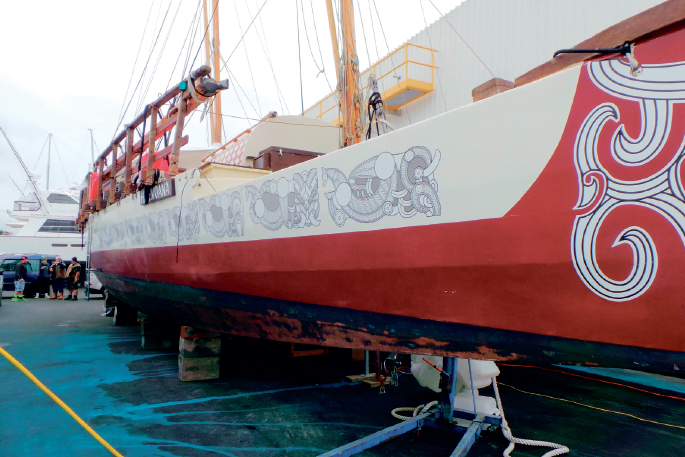The Hinemoana waka will have a bit more engine when she re-enters the water following the pre-season spruce up.
Solar-powered electric motors are being replaced with a pair of small diesels that will run biofuel.
The biofuel helps keep the waka’s carbon footprint low, and the extra horsepower will remove a lot of anxious moments for the crew, says skipper Pat Mohi.
The electric motors gave the waka about three knots, which while providing some power when becalmed in mid ocean, made no headway against the four-to-five knot tidal stream in the Tauranga harbour entrance.
It meant voyages relied on wind power, and arriving and departing had to coordinate with the tides.
“It’s still an experience for the younger ones co-ordinating the tides for entry into the and out of the harbour,” says Pat, “but sometimes we had to do it when it is dark.
“It’s good experience for the younger ones, but for the crew it alleviates a lot of pressure.”
With the waka gaining an expected cruising speed of about eight knots, the new motors will also make keeping up with the Hinemoana’s increasingly busy schedule less stressful while increasing the operating range.
“We can get around a lot further, we can see more. It will enhance our programme so much more. The results we had last year suggest people enjoyed themselves and we have learned a lot from it.”
The people from the first season are recommending the voyage to others - the result of which sees bookings for the ten-day voyages through to next year.
There’s been a bit of pre-season work on the crew as well, says Pat. They have gone through courses, from working with youth, to teaching methods, as well as the first aid and fire safety.
“The people are buying into what we have always believed in, and we seem to be doing okay,” says Pat.
All volunteers working on the waka have been involved for years and years, such as Angelo, a Fijian skipper on different waka.
“They have always known what a waka can do for the community, so they are here to help. They’re repainting, sanding and making it as good as ever.
“As they say, it takes a village to raise a kid and it takes a community to raise a waka.”
The repowering also makes wintering in Fiji more likely.
“It’s really sad to see a waka parked up in the winter months because you know she should be out there sailing. She’s a traditional Polynesian voyaging canoe, so looking at her in the sun and those turquoise waters, she’s happy too.”
He’s also hoping they will be able to earn enough taking tourists and guests on waka voyages to be able to subsidise costs for some of their New Zealand voyagers.
“We would like to go up there and offer an authentic cultural experience on board a waka, taking passengers or clients between islands, giving them an experience of what a waka is about in that environment.”
The hope is that they make enough in Fiji to subsidise some of the youth programmes in New Zealand. Hinemoana is one of seven waka designed and built in Auckland in 2009 for Te Mana o Moana, the Spirit of the Ocean voyage. Hinemoana was the flagship.
“She was built to cater all the small islands that couldn’t maintain and keep the vessel to themselves,” says Pat.
“So on the deck and throughout the vessel are designs and symbols that come from each of the different islands. She is the pan-Pacific vessel that incorporates all the traditions of Polynesia as well as Micronesia and Melanesia.”
As the flagship waka, Hinemoana has been everywhere, from one side of the Pacific Ocean to the other and the islands in between. The hull design, with the characteristic raised sterns, originates in Rarotonga and is believed to be similar to the vessel type used in exploring and migrating to the lower South Pacific.
Pat regards them as the buses of the ocean from Rarotonga, where he says the whole art of Polynesian navigation came from.



0 Comments
Leave a Comment